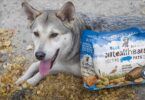Have you ever watched your furry friend push away their food bowl, their tail drooping with disinterest? It’s a moment that tugs at every pet owner’s heart. When our companions feel unwell, finding ways to nourish them becomes a quiet mission—one where simple solutions often shine brightest.
Many pet parents turn to savory liquids to entice picky eaters or support recovery. These nutrient-rich additions can transform dry kibble into an appetizing meal, especially for sensitive stomachs. Veterinarians like Dr. Valerie Parker emphasize their value when prepared mindfully, free from harmful ingredients like onion or garlic.
This article explores how to safely incorporate these flavorful boosts into your pup’s routine. You’ll learn about their digestive benefits, expert-approved options, and creative ways to enhance meals. Whether homemade or store-bought, prioritizing quality ensures your companion gets the hydration and nutrients they deserve.
Let’s dive into a world where wellness meets wagging tails—one spoonful at a time.
Understanding the Benefits and Safety of Chicken Broth for Dogs
When pets need gentle nourishment, savory liquids can become a wellness ally. These additions offer more than flavor—they deliver essential vitamins like B12, minerals such as magnesium, and amino acids that support muscle repair. Veterinarian Dr. Lisa Freeman notes their role in liver function, stating: “Properly prepared options help detoxify organs while boosting energy levels.”
Nutritional Value and Health Benefits
High-quality formulas provide hydration for active companions, particularly during recovery. Their liquid consistency softens kibble, making meals easier to digest. This is especially helpful for sensitive stomachs or after medical procedures.
Look for store-bought versions labeled “low-sodium” and free from onion or garlic. Homemade recipes allow control over ingredients, ensuring only beneficial elements like collagen enter your pet’s bowl. Always prioritize bone-derived varieties for joint-supporting glucosamine.
When and Why to Use Broth for Your Dog
Introduce these liquids gradually during transitions to bland diets or heatwaves. They encourage hydration in reluctant drinkers and add variety to repetitive meals. Some senior animals benefit from the extra moisture in dry food.
Consult your vet before adding broths to specialized diets. While generally safe, individual needs vary based on age, weight, and existing conditions. With mindful use, this supplement becomes a versatile tool in nurturing your companion’s well-being.
How to Safely Prepare Chicken Broth for Dogs at Home
Creating nourishing meals in your kitchen lets you control what goes into your pet’s bowl. Start with fresh bones or meat cuts—avoid seasoned or processed options. Skip onions, garlic, and excess salt, as these can harm your companion.
Selecting Dog-Friendly Ingredients
Choose organic, lean cuts to maximize nutrients. Bones from poultry or beef add collagen, which supports joint health. Always use filtered water to reduce contaminants. Dr. Parker advises: “Simmering bones slowly releases minerals without overheating delicate compounds.”
Step-by-Step Preparation Guide
Place ingredients in a pot and cover with water. Bring to a boil, then reduce heat to a gentle simmer for 3-4 hours. Skim foam regularly to remove impurities. Let the mixture cool until warm before serving.
This method preserves collagen while eliminating risks from high heat. Leftover meat becomes a soft treat for older pets or those with dental issues. Stir a spoonful into dry food to boost appetite during recovery.
Store portions in airtight containers for up to five days. Freeze extras in ice cube trays for easy portioning. Experts like Dr. Linder recommend rotating homemade options with vet-approved store brands for balanced nutrition.
Incorporating Broth into Your Dog’s Daily Diet
Transforming everyday meals into tail-wagging experiences starts with simple additions. Bone-based liquids can elevate both nutrition and enjoyment, turning routine feedings into moments pets anticipate. Let’s explore practical ways to integrate these nourishing boosts.
Enhancing Dry Food with Broth
A splash of warm bone broth softens kibble, making it easier to chew for seniors or pets with dental concerns. This method also releases enticing aromas, encouraging picky eaters to finish their meals. For sensitive stomachs, lukewarm options aid digestion without overwhelming delicate systems.
Creative Treats and Meal Enhancers
Freeze low-sodium formulas in ice cube trays for hydrating summer snacks. Mix thawed cubes with mashed pumpkin or blueberries for nutrient-rich “pupsicles.” Stir cooled broth into plain yogurt, then freeze in silicone molds for probiotic-rich rewards.
Blend bone broth with pureed vegetables to create a gravy for raw diets. This adds moisture and vitamins while maintaining balanced nutrition. During diet transitions, gradually replace water with broth in new foods to ease acceptance.
These strategies turn basic meals into gourmet experiences. They support hydration, joint health, and overall vitality—proving small changes can yield big results.
Exploring Chicken Bone Broth and Its Unique Benefits
Not all savory liquids offer the same nutritional punch for pets. While standard options add flavor, bone-derived varieties deliver concentrated nutrients through extended cooking methods.
Differences Between Regular and Bone Broths
Traditional versions often use meat scraps and cook briefly. Bone broth simmers for 12-24 hours, extracting collagen from connective tissues. This creates a gelatin-rich base packed with glucosamine and chondroitin.
Slow cooking releases minerals like calcium and phosphorus. These elements strengthen bones while aiding digestion. Pets with sensitive stomachs may benefit from its gut-soothing properties.
Collagen, Glucosamine, and Joint Health
Collagen forms the building blocks of cartilage. Aging or active animals often need extra support. Adding bone broth to their diet helps maintain mobility and reduces inflammation.
For pets with leaky gut, the amino acids in collagen repair intestinal lining. Freeze portions in ice cube trays for controlled servings. Thawed cubes can be mixed into dog food or offered as chilled snacks.
Always choose low-sodium recipes without onion or garlic. While research is ongoing, many owners report improved energy levels and coat quality. Introduce gradually—½ teaspoon per 10 pounds of weight—to avoid digestive upset.
Nutritional Considerations and Expert Recommendations
Navigating your pet’s nutritional needs requires attention to detail. Savory liquids can offer health benefits, but quality matters. Always prioritize formulas labeled “low-sodium” and free from onion or garlic powder—common hazards in store-bought options.
Monitoring Sodium Levels and Other Additives
Excess salt strains kidneys and worsens heart conditions. Dr. Parker advises checking labels for hidden additives like monosodium glutamate. Homemade versions let you control ingredients, making them broth safe for sensitive pets.
Start with filtered water and high-quality bones from trusted sources. Slow simmering preserves nutrients while avoiding harmful byproducts. Store leftovers in small portions to maintain freshness.
Consulting with Your Veterinarian for Special Diets
Pets with diabetes or gastrointestinal issues need tailored plans. Dr. Linder recommends discussing portion sizes and frequency before introducing new supplements. Even natural options might clash with prescribed medications.
For homemade recipes, use lean cuts and avoid fatty scraps. A simple step-by-step approach ensures hygiene and nutrient retention. Most vets suggest limiting servings to ¼ cup daily for medium-sized animals.
Balancing flavor with safety maximizes health benefits. With careful planning, these nourishing additions become a trusted ally in your companion’s wellness journey.
Final Thoughts on Enhancing Your Dog’s Diet with Natural Broths
Small dietary tweaks often yield lasting wellness rewards. Natural broths simmered for hours unlock nutrients that support digestion, hydration, and appetite—especially valuable during recovery or seasonal changes. These savory liquids transform ordinary meals while nurturing a healthy gut.
Quality matters. Always skip harmful additives like garlic and excess salt. Use a large pot for homemade versions, allowing collagen-rich bones to release minerals slowly. Serve lukewarm to protect sensitive stomachs and maximize nutrient absorption.
Veterinary guidance ensures these additions align with your pet’s unique needs. Freeze leftovers in cube trays for portion-controlled treats or mix into dry food. Gradual introduction helps identify preferences and tolerances.
When prepared thoughtfully, these kitchen staples become more than meal enhancers—they’re tools for sustained vitality. Start with simple recipes, observe your companion’s response, and celebrate each wagging tail as proof of thoughtful care.
FAQ
Can store-bought versions harm pets?
Some commercial products contain onions, garlic, or excess salt, which are unsafe. Always check labels for dog-friendly ingredients or opt for homemade alternatives.
What makes bone-based versions different?
Simmering bones releases collagen and glucosamine, which support joint health and digestion. Regular options lack these nutrients from extended cooking times.
Which ingredients are toxic in homemade recipes?
Avoid onions, garlic, grapes, and added salt. Stick to plain meats, bones, and vegetables like carrots or celery.










Leave a Comment